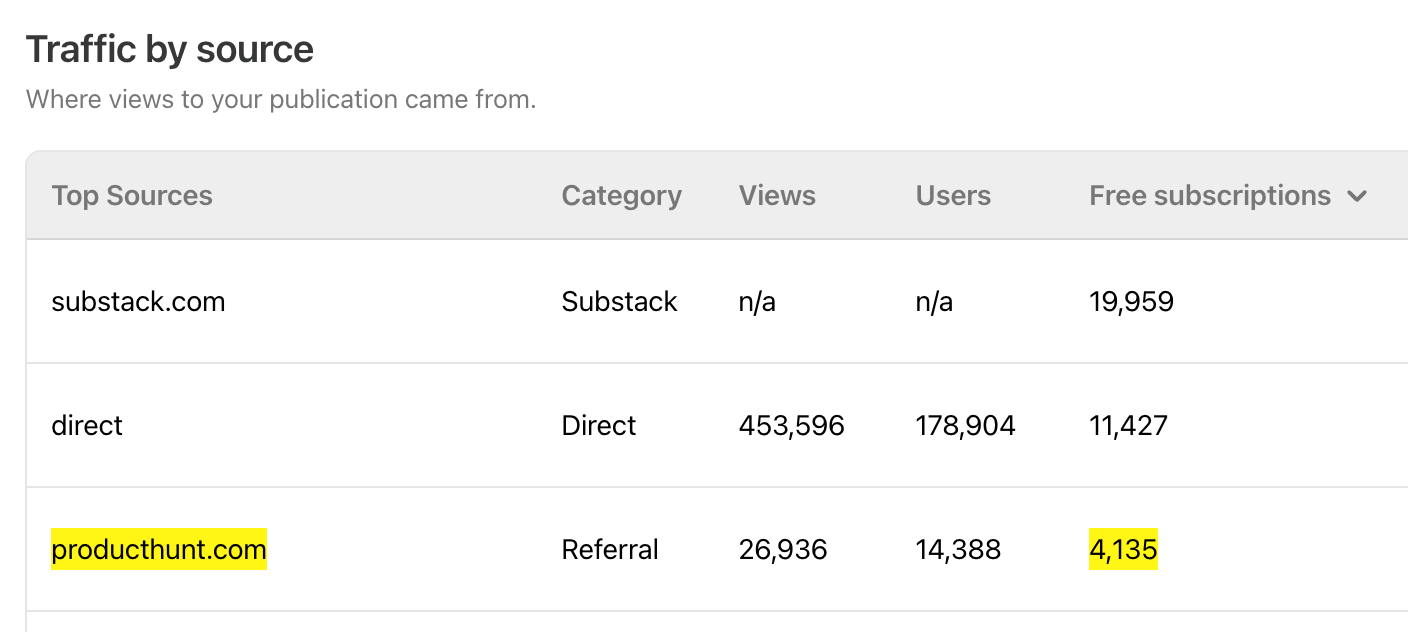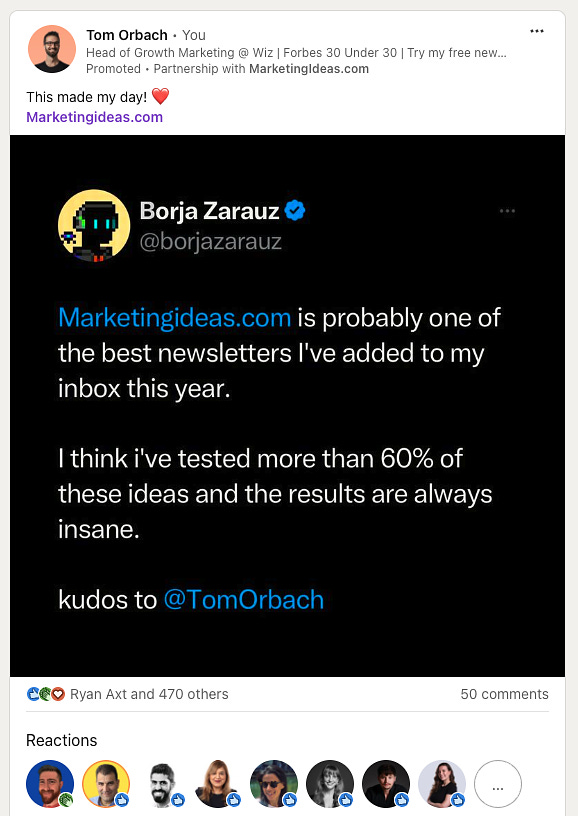10 unconventional things I'm doing to grow my newsletter 📈
40,000 subscribers, baby!
Today, I’m celebrating 40,000 subscribers to Marketing Ideas in less than 2 years, which is incredibly humbling. 🥰
I've already shared my ultimate Substack growth playbook:
Here’s a special behind-the-scenes look at 10 more unconventional growth tactics I’ve used along the way:
#1
I’ve produced 300+ yellow lightbulb stress balls with my domain name printed on them. They live in my backpack and come with me to meetups, roundtables, exec dinners, and conferences.
Why? Two reasons:
First, they’re the perfect ice breaker. During intros I say my newsletter aims to give you a lightbulb moment - then I hand out actual lightbulbs :)
Second, it’s a super-easy hack for conferences. At the Newsletter Conference in NYC, I stood at the entrance 5 minutes before sessions started and handed one to each person walking in. The audience was filled with my branded lightbulbs.
The stress ball format is the secret - people actively play with them publicly instead of tossing them in their bag (…or trash) like most swag.
👉 How many subscribers it brought: ~100
#2
I include infographics in my emails even when no visualization is actually needed.
Why? Because they give people something to share that makes them look smart (versus just sharing a link to my article). Even when the infographic repeats my text verbatim with zero added value, people love sharing them!
👉 How many subscribers it brought: ~500
#3
Every time I publish a “Comment your thing and I’ll give you free marketing ideas” post → I get hundreds of new subscribers.
My secret is that I include a P.S. more ideas in my newsletter plug at the bottom of each reply.
I can repurpose existing ideas from past newsletters, which drives traffic back to my website. Plus, some people even publish their own posts about my advice, which drives even more traffic!
My best performing posts:
LinkedIn: 250 new subs
Substack Notes: 400 new subs
And the coolest thing is that I now have a spreadsheet showing marketing leaders from Amazon, WalkMe, Honeybook (and others) all asked me for advice. Not sure what I’ll do with it but it’s pretty cool.
👉 How many subscribers it brought: 650
#4
I collect “unofficial testimonials”. I track every positive comment about my newsletter found online and display them all here: https://shoutout.io/marketing-ideas
These are not official testimonials - just public comments people made. But I unapologetically collect them without asking (because they’re already public).
I periodically share screenshots and quotes from these comments, which help generate new subs.
👉 How many subscribers it brought: Unknown (branding effort)
#5
I love Paul Graham’s mantra “Do things that don’t scale”.
Whenever someone sends me a connection request on LinkedIn and fits my target audience, I manually send them this message:
I can’t say exactly why but people LOVE this message, always replying warmly and subscribing. Even those who think it’s automated end up subscribing 🤓
I’ve sent over 1,000 of these DMs. It’s a “why not?” kind of tactic with only upside. These people approached me first, after all.
👉 How many subscribers it brought: ~400
#6
I hunt Twitter (X) for new “vibe coding” projects and buy cheap ads on ones I think might blow up someday.
For example, I saw Pieter Levels (famous internet creator) engaging with someone who made a sailing game. So I paid $100/month to sponsor an “island” in the game with my newsletter URL displayed on it.
Result after two months? One new subscriber. Lol. I canceled the sponsorship, but the logic is simple: if any of these projects explodes with millions of users while I have a cheap sponsorship locked in, the payoff could be huge.
It’s basically placing small bets on future viral hits - terrible ROI so far but fun to do.
👉 How many subscribers it brought: 1
#7
My greatest growth lever is Substack Recommendations, and I’ve developed a system for consistently getting more recommendations:
I recommend other Substack writers and promote them (without speaking to them beforehand). I don’t message them or expect anything in return.**Here’s the twist: Substack shows you exactly how many subscribers you've generated for others. I use these stats as an excuse to reach out ONLY after I’ve sent them enough subscribers.
For example, my recommendations generated over 2,000 subscribers for one writer who didn’t know me. I sent her a LinkedIn message mentioning this, and she immediately recommended my newsletter in return - adding 500+ subscribers to my list in just 5 minutes of work.
This pattern has repeated with other creators (though in smaller quantities). They always reply to my cold DMs when I show concrete value I’ve already delivered.
👉 How many subscribers it brought: 9,200 in total
#8
Product Hunt is also a huge growth engine for me. I launched in February 2024 and still get dozens of new subscribers monthly from it passively (15 months later!)
Most newsletters don’t launch on Product Hunt because the website’s curation team typically “cancels” newsletters - they prefer featuring actual products and SaaS.
My workaround? I didn’t call it a newsletter at all. I presented it as a marketing ideas “GALLERY” which fit better with Product Hunt’s product-focused narrative.
I’m surprised more newsletters aren’t doing this.
Here’s my full guide on how to frame your newsletter for Product Hunt to get a constant subscriber stream.
👉 How many subscribers it brought: 4,135 + more unattributed
#9
You can run ads on LinkedIn with your personal profile through “Thought Leadership Ads”. Just publish a regular post and boost it.
My advice: Only boost posts that already succeeded organically at bringing subs. No amount of paid promotion will save a bad post.
My top two posts I regularly boost:
A screenshot of a testimonial I found on Twitter:
A “who reads this newsletter” graphic featuring big logos (I exported my subscriber list, had ChatGPT identify companies, and designed the visual)
I average about $2.30 per new subscriber from these ads. Not the cheapest acquisition method, but it brings high-quality subscribers consistently.
👉 How many subscribers it brought: 1,700
#10
My final point shouldn’t be unconventional, but it sadly is:
I remain a marketer first, newsletter writer second. 🧪
I’m more focused on running marketing experiments with Wiz (where I’m Director of Growth Marketing), advising friends, and testing ideas with my own newsletter - than actually writing about them. If I only wrote about marketing ideas without actually implementing them → this newsletter would have a 0% success rate.
For anyone writing a newsletter: Always prioritize your profession first, writing second. Expertise above all else.
👉 How many subscribers it brought: I guess all of them.
See you next week,
Tom
If you enjoyed this article, you may also like my ultimate Substack growth playbook:

















Congrats Tom!
I don't think a single week has passed where I haven't read an edition of Marketing Idea. There also hasn't been a week where I haven't used any of your Marketing Ideas. What you're doing here is awesome, and I'm your #1 fan.
Great ideas again Tom! Your success comes from practicing these ideas in the real world!